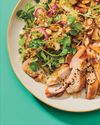
Every few weeks during my social media scroll, I'm served a new version of a meme that goes something like this: "Welcome to your 30s, where sneezing wrong means two weeks of low-back pain." Each time, I chuckle knowingly.
Given that these posts rack up thousands of likes and shares, it's clear I'm not the only one experiencing fits of lumbar lousiness. Research proves me right: Up to 23 percent of the world's adults suffer from chronic low-back pain, with up to 84 percent of people experiencing at least one bout of low-back pain during their lifetime. (Adding insult to injury: Women of all ages are more likely to suffer from it than men, studies show.) The pandemic exacerbated the issue-and in ways you might not expect.
Both the prevalence and the intensity of low-back pain increased during this period, compared with pre-pandemic rates, a recent meta-analysis found-due in part to more sedentary living. The other piece(s)? Stress and anxiety, which are both contributing factors, other research confirms.
If you're feeling crunchy and resigned to living with it because you're in your 30s (or 40s or 50s), you don't have to! See what experts prescribe for managing, even eradicating, stiffness and soreness in our modern world.
PAIN POINTS
First things first: Let's define the terms. Here, we'll focus on what's known as "nonspecific" low-back pain-an ache or stiffness that doesn't stem from a diagnosable condition, like a herniated disc or an infection. (If you believe you've injured your back or your pain is a 5 on a scale of 1 to 10, see a doc!) Nonspecific low-back pain accounts for 80 to 90 percent of all low-back pain, per The New England Journal of Medicine, and ranges from acute (less than 6 weeks) through subacute (6 to 12 weeks) to chronic (more than 12 weeks).
Esta historia es de la edición July - August 2023 de Women's Health US.
Comience su prueba gratuita de Magzter GOLD de 7 días para acceder a miles de historias premium seleccionadas y a más de 9,000 revistas y periódicos.
Ya eres suscriptor ? Conectar
Esta historia es de la edición July - August 2023 de Women's Health US.
Comience su prueba gratuita de Magzter GOLD de 7 días para acceder a miles de historias premium seleccionadas y a más de 9,000 revistas y periódicos.
Ya eres suscriptor? Conectar

Silver Linings Playbook
You can learn how to become more optimistic, no matter your starting point.

THE RISE of the GENTLE C-SECTION
How a new surgical practice is transforming women's childbirth experience

The Next Health Tech Revolution Is Here
From smart watches to tracking apps, devices are providing valuable insights.

Planting New Roots
Six late-bloomer lesbians\" share their stories of how they learned to live—and love—authentically.

GROWING FORWARD
Country singer KELSEA BALLERINI is working harder than ever to shake (and remake) old patterns that no longer serve her. Here, she opens up about her intentional journey and shares her mental health musts.

"Learning to Ski at 57 Helped Me Embrace Uncertainty"
Tackling something new-and terrifying was exactly what one freshly single midlifer needed.

Grain Gains
This cozy quinoa salad paired with juicy chicken thighs clocks nearly 50 grams of protein.

Healthy Eats, Delivered
It might be possible to say soodbye to grocery stores forever. But should you? yee

Shower Power
How one writer improved her mental health by connecting with her body

Scent Solutions
What was once a taboo subject-body odor-is now a convo more and more people are happily having.